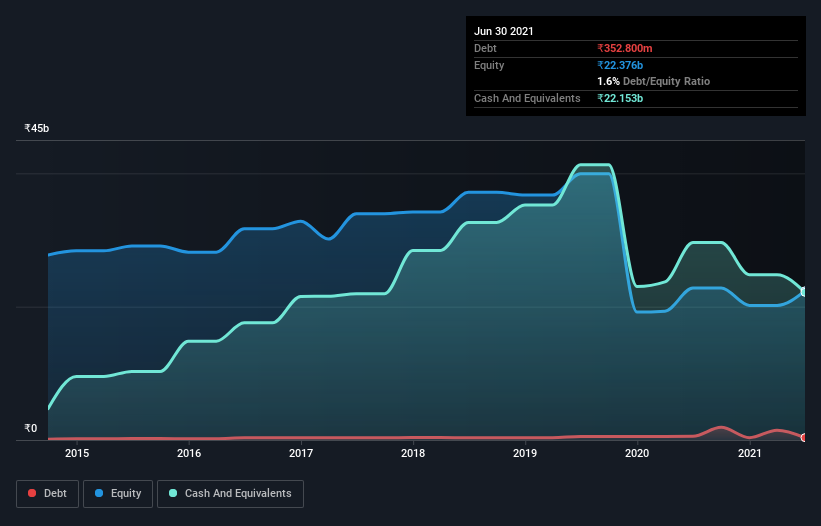We Think Nestlé India (NSE:NESTLEIND) Can Manage Its Debt With Ease

Some say volatility, rather than debt, is the best way to think about risk as an investor, but Warren Buffett famously said that 'Volatility is far from synonymous with risk.' When we think about how risky a company is, we always like to look at its use of debt, since debt overload can lead to ruin. Importantly, Nestlé India Limited (NSE:NESTLEIND) does carry debt. But should shareholders be worried about its use of debt?
Why Does Debt Bring Risk?
Debt and other liabilities become risky for a business when it cannot easily fulfill those obligations, either with free cash flow or by raising capital at an attractive price. In the worst case scenario, a company can go bankrupt if it cannot pay its creditors. However, a more usual (but still expensive) situation is where a company must dilute shareholders at a cheap share price simply to get debt under control. By replacing dilution, though, debt can be an extremely good tool for businesses that need capital to invest in growth at high rates of return. When we think about a company's use of debt, we first look at cash and debt together.
See our latest analysis for Nestlé India
How Much Debt Does Nestlé India Carry?
The image below, which you can click on for greater detail, shows that Nestlé India had debt of ₹352.8m at the end of June 2021, a reduction from ₹562.2m over a year. However, it does have ₹22.2b in cash offsetting this, leading to net cash of ₹21.8b.

A Look At Nestlé India's Liabilities
Zooming in on the latest balance sheet data, we can see that Nestlé India had liabilities of ₹23.2b due within 12 months and liabilities of ₹35.3b due beyond that. On the other hand, it had cash of ₹22.2b and ₹2.12b worth of receivables due within a year. So its liabilities total ₹34.3b more than the combination of its cash and short-term receivables.
Having regard to Nestlé India's size, it seems that its liquid assets are well balanced with its total liabilities. So while it's hard to imagine that the ₹1.73t company is struggling for cash, we still think it's worth monitoring its balance sheet. While it does have liabilities worth noting, Nestlé India also has more cash than debt, so we're pretty confident it can manage its debt safely.
And we also note warmly that Nestlé India grew its EBIT by 15% last year, making its debt load easier to handle. When analysing debt levels, the balance sheet is the obvious place to start. But it is Nestlé India's earnings that will influence how the balance sheet holds up in the future. So if you're keen to discover more about its earnings, it might be worth checking out this graph of its long term earnings trend.
Finally, a business needs free cash flow to pay off debt; accounting profits just don't cut it. While Nestlé India has net cash on its balance sheet, it's still worth taking a look at its ability to convert earnings before interest and tax (EBIT) to free cash flow, to help us understand how quickly it is building (or eroding) that cash balance. Over the most recent three years, Nestlé India recorded free cash flow worth 72% of its EBIT, which is around normal, given free cash flow excludes interest and tax. This free cash flow puts the company in a good position to pay down debt, when appropriate.
Summing up
We could understand if investors are concerned about Nestlé India's liabilities, but we can be reassured by the fact it has has net cash of ₹21.8b. The cherry on top was that in converted 72% of that EBIT to free cash flow, bringing in ₹19b. So is Nestlé India's debt a risk? It doesn't seem so to us. When analysing debt levels, the balance sheet is the obvious place to start. However, not all investment risk resides within the balance sheet - far from it. To that end, you should be aware of the 1 warning sign we've spotted with Nestlé India .
Of course, if you're the type of investor who prefers buying stocks without the burden of debt, then don't hesitate to discover our exclusive list of net cash growth stocks, today.
If you decide to trade Nestlé India, use the lowest-cost* platform that is rated #1 Overall by Barron’s, Interactive Brokers. Trade stocks, options, futures, forex, bonds and funds on 135 markets, all from a single integrated account. Promoted
Valuation is complex, but we're here to simplify it.
Discover if Nestlé India might be undervalued or overvalued with our detailed analysis, featuring fair value estimates, potential risks, dividends, insider trades, and its financial condition.
Access Free AnalysisThis article by Simply Wall St is general in nature. It does not constitute a recommendation to buy or sell any stock, and does not take account of your objectives, or your financial situation. We aim to bring you long-term focused analysis driven by fundamental data. Note that our analysis may not factor in the latest price-sensitive company announcements or qualitative material. Simply Wall St has no position in any stocks mentioned.
*Interactive Brokers Rated Lowest Cost Broker by StockBrokers.com Annual Online Review 2020
Have feedback on this article? Concerned about the content? Get in touch with us directly. Alternatively, email editorial-team (at) simplywallst.com.
About NSEI:NESTLEIND
Nestlé India
Manufactures and sells food products in India and internationally.
Adequate balance sheet average dividend payer.

